Did you find holes in your carpet or other clothing in your home? Did you find something that looks like a carpet worm? Did you just find a bettle that looks something like one of these?
Ok, I have something to tell you… but don’t freak out!
Your home might be infested with carpet beetles.
Don’t worry! I promise you there’s a solution to this problem. I know it might seem impossible to solve, but you can easily get rid of carpet beetles yourself.
In this post we’re going to learn everything there is to know about carpet beetles… what they look like, how they reproduce, whether or not they’re harmful, the different types… and most importantly… how to get rid of them or when you should call a professional.

Before we start though, many of you have asked many times about how to differentiate carpet beetles from bed bugs. It’s not a difficult question to answer, but since we don’t want to go off topic, we wrote a post about Carpet Beetles vs Bed Bugs and how to differentiate them.
Check it out and come here to learn how to get rid of carpet beetles!
What are Carpet Beetles?
There are over 350,000 estimated species of beetles on planet Earth. That makes Beetles one of the most abundant lifeform on Earth at over 25% of the lifeforms on the planet.
But although we do have to share the planet with them, there’s no reason why we should share our homes with them. We specifically want the Carpet Beetles far far away from our homes.
Carpet beetles (a.k.a Anthrenus verbasci) are a very common species of beetles. They belong to the family of beetles known as dermestids. In this current year (2022) is one of the most common pests in all North America (including warehouses, homes, museums, etc.). You can find them pretty much on every State, but they’re more destructive on warmer climates. That’s why it’s usually associated with a southern pest.
They’re considered a pest because of how quickly they reproduce and because they can digest keratin. Keratin is the principal protein found in animal hair and feathers.
That means that if you have in your house anything (clothes, upholster or carpet) made out of (silk, wool, fur, skins, leather, fur, etc.)… you’re susceptible of being invaded by this little (and annoying) bugs. And they’re voracious! They can cause serious damage to your stuff:
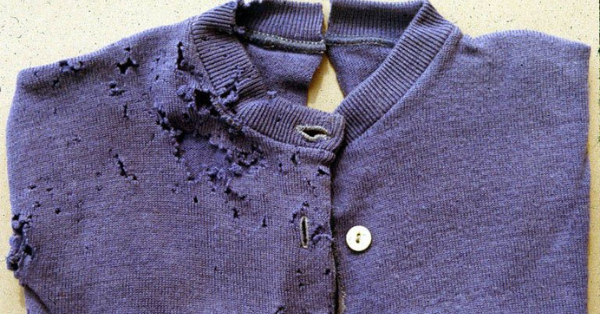
What do Carpet Beetles look like?

There are a couple of carpet beetle types, so it’s hard to describe all of them. But this is how you might identify them:
– Adults are shaped like an oval and 1.7 to 3.5 milimeters long. They can be of a brownish (or orange) color with white and black spots or deep black.
– Larvae are larger than adults. They canbe 4 to 5 milimiters long and have an elongated hairy body (very worm-like).
How do Carpet Beetles reproduce: the Larvae
We’re going to be talking about the larvae quite a lot for one reason… We need to understand their breeding if we want to remove them for ever from our homes.
Why?
Because the Carpet Beetle has a life cycle than can go from 1 to 3 years. And they can produce up to 4 generations per year! Do the math and you’ll reach the same conclusion I did… This little creatures breed like wildfire!
Females lay between 40 and 90 eggs. The eggs are tiny! 0.35 milimeters! But you can see them without a microscope. Although they are quite hard to see in real life because the females usually deposit the eggs in cracks near the food sources. Most of the time Larvae hatch from eggs in the late spring and early summer. But this might depend on the all around temperature where you life.
PRO TIP
EGGS CAN LIVE EVEN IF YOU KILL ALL THE ADULTS
Understanding larvae is also very important because you could kill all the adults, but many eggs could be calmly sleeping in the shadows. Don’t worry! We’ll learn how to get rid of both adults, and larvae.
Are Carpet Beetles harmful?
Carpet Beetles can make you not want to step again inside your home. But how harmful are they?
– Carpet Beetle Bite
First of all, carpet beetles don’t bite humans. They’re scavengers. That means that they almost exclusively feed on dead animals. And humans aren’t on the menu fortunately.
If you think that a Carpet Beetle may have bitten you, it may very well have been a bed bug. Check our post on Carpet Beetles vs Bed Bugs to learn more!
Carpet Beetles don’t transmit any disease (like mosquitos do) that is harmful to human. So, hurray us!
– Fabrics
But Carpet Beetles are extremely harmful to certain animal-based materials such as feathers, silk, wool, fur, skins, leather, fur, etc.
Well… not the adults. Only the larvae eat animal fibers.
In nature, they commonly proliferate on bird nests, animal carcases, or dead insects. Anywhere where they can find animal fibers close.
That’s why love attics, chimneys, basements and other low light rooms. And why the most common victims are usually sweaters, scarves, blankets, rugs, pillows, upholstery, toys, taxidermy mounts. And of course… natural carpets!

But don’t think for a second that you’re save just because you own a carpet that’s built with synthetic materials (such as polyester or rayon). Many times synthetic carpets are blended with wool to make them softer.
And even if your carpet is 100% synthetic, you may have an infestation if you don’t clean food stains the right way. Although it’s not as likely as in natural carpets.
If you want to learn how to clean 28 different types of stains (crayons, coffee, ketchup, gum, etc.) we created the Ultimate Stain Cleaning Guide.
– Allergies
Although Carpet Beetles don’t bite, that doesn’t mean that they’re not harmful to humans. Some people are allergic to carpet beetles.
They cause what’s called a Carpet Beetle Rash.
This allergic reaction can happen when an allergic person comes in contact with the larvae bristles (skin, eyes, airways… etc.)
The symptoms don’t difer a lot from other allergic reactions: Red, ichly and wayery eyes; itchy skin, etc.
But even someone who is not allergic could have an adverse reaction against carpet beetles. This usually happens when you inhale the shed skins of the larvae. You might not even know that you’re breathing their dead skin, but when you do you might experience airways irritations.
Types of Carpet Beetles
There are 3 main types of carpet beetles in the USA. All of these can cause serious damage. These are the 3 bugs you want to stay away from:
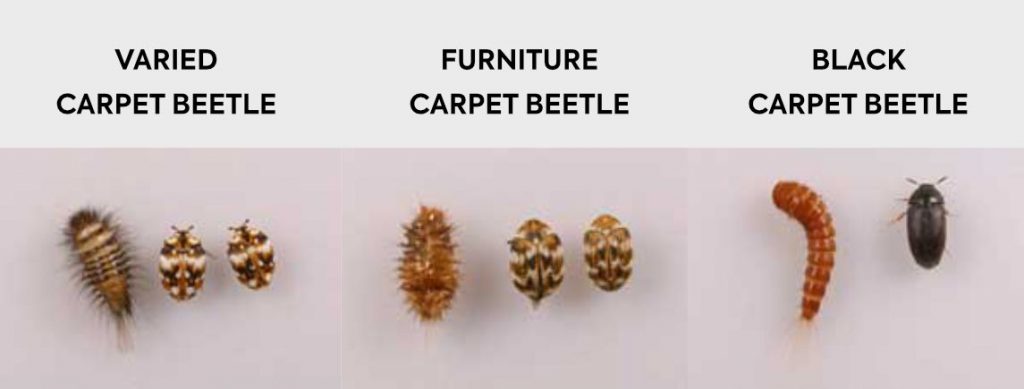
– Varied Carpet Beetles

The Varied Carpet Beetle (a.k.a. Anthrenus verbasci, is about 1/10 inch long and has an irregular pattern of colors on it’s wings: white, brown and an orange-yellowish colors.
This type of carpet beetle usually places their eggs near wool carpets and rugs (or animal skins). And although you might have them through out the year, the adults usually appear on late spring and early summer. They’re quite easy to identify, because they tend to go towards the windows.
The Varied Carpet Larvae are just slightly larger than the mature beetle. They have a lot of hair and are the only carpet beetle larvae that’s broader in the rear.
– Furniture Carpet Beetle
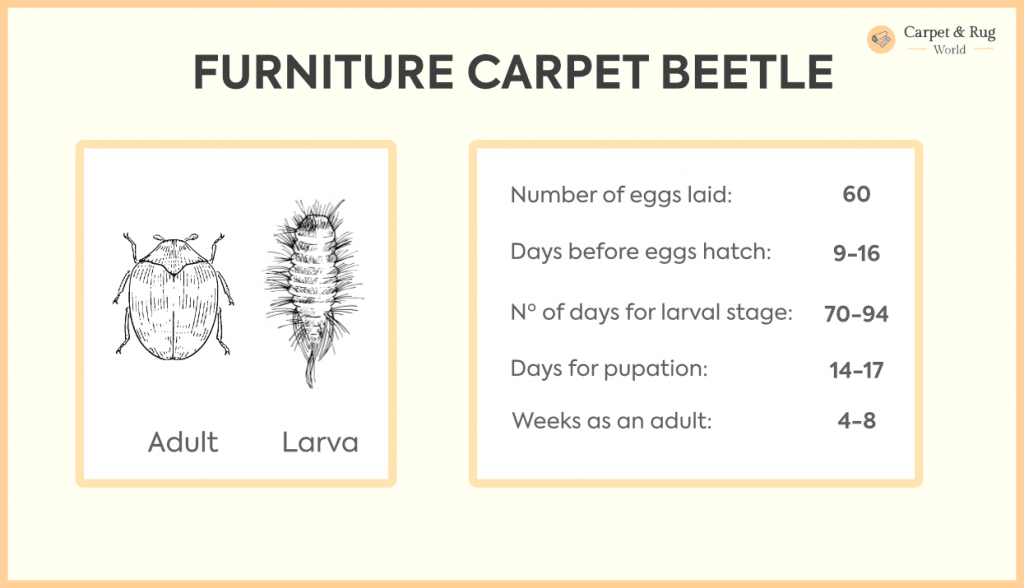
The Furniture carpet beetle (a.k.a. A. flavipes) looks similar to the varied carpet beetle. Although they are larger and rounder, and the colors are more vivid. And their undersides are white too.
They can also be mistaken with the black carpet beetle because when their scales wear off, they turn black. But the Furniture Carpet Beetle is very round compared to the Black Carpet beetle.
The Larvae’s color depends on how mature it is. They’re white at the earlier stages of development, and tend to darken (a chestun brown color is very common) as they mature. They’re found in the same places Varied Carpet Beetles are usually found.
– Black Carpet Beetle
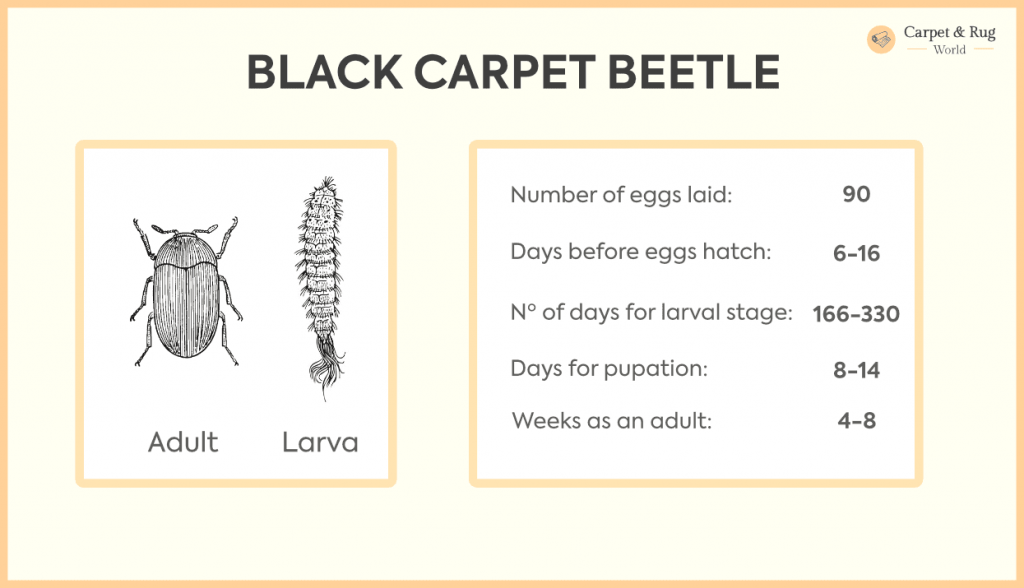
Last, but not least we have the Black Carpet Beetle (a.k.a. Attagenus unicolor). These are easiliy distinguishable because of their sinhy black color and brownish legs.
The larvae are very different too. They’re hard and have short (but stiff) hair. They’re also longer than their Furniture and Varied cousins.
How do Carpet Beetles get inside your house?
Carpet beetles are so common, they get inside your home through doors and windows. Some can come with plants and flowers that are brought inside. Or even from furnuture, clothing or infested rugs.
Some thrive, some don’t. But when they find a source of food, their numbers can grow quickly.
How to prevent carpet beetles
As it happens with most things in live, preventing infestations is the best way of dealing with carpet beetles.
How?
Follow these 5 tips:
1. Clean regularly
The cleaner your house is, the least likely you’ll suffer of any type of infestation. Being constant is key!
2. Vacuum your carpet
You might not see them, but you do pick up many beetles while you’re vacuuming. So, the more you vacuum, the more likely that you’ll get rid of those pests before they even happen!
But you must have a good vacuum cleaner. As it happens with most electric devices, vacuum cleaners lose power over time. So make sure your vacuum cleaner is powerful enough! If you’re on the market for a vacuum cleaner, we have an article you might be interested in: Best Vacuum Cleaners 2022

Also, if you’re about to change your carpet and have had problems with carpet beetles in the past, you might want to choose a synthetic carpet. As we said earlier on in the post, it’s not a guarantee that an infestation won’t happen but it will help.
You might want to check our guides on the different types of carpets and types of rugs.
3. Use a preventative spray.
This is specailly useful if you’ve had carpet beetles in the past. There are some great products in the market that won’t only kill all the beetles and their larvae, but will continue to kill up to 12 months later.
This is the one we recommend because of how great it works:
[amazon link=”B000RNH36O” title=”Home Pest Control Indoor and Outdoor Insect Killer”/]
[amazon box=”B000RNH36O”]
4. Use Boric Acid
Boric acid is a substance that prevents carpet beetles. They simply don’t like it! You can sprinkle some of it around the furniture and the edges of your carpet (where carpet beetles usually attack first) and vacuum the excess 2 hours later.
You can buy Boric Acid on Amazon. It’s very inexpensive!
[amazon link=”B001V9WY0S” title=”Boric Acid Powder, 6 oz.”/]
[amazon box=”B001V9WY0S”]
5. Store with mothballs & Plastic
Sometimes carpet beetles go unnoticed for a long period of time (years!) because they start eating your stored clothes and move to other parts of your home from then.
If you don’t want that to happen to you, there are two things that you can do:
1. Store with mothballs. They work like a charm and are extremely simple to use!
2. Store in plastic. This is specially true for taxidermy collectables. If there’s plastic aroudn them, the beetles won’t be able to reach them.
How to get rid of Carpet Beetles Yourself
Now, for the part that you were waiting for! How to get rid of Carpet Beetles!
We’re going to eliminate carpet beetles using a simple 3 step method. But you have to follow the method carefully if you want to be able to remove all the beetles and the larvae. And even then, some infestations are so widely spread that require professional equipment.
So try to follow these steps and be thorough! Take your time. It’s worth it!
Step 1: Prepare Your Home for Treatment
– Find the primary source of infestation

The first thing we’re going to do is to find all the infested items in the house. This is going to take a while… but you have to be thorough! If you leave just one infected item, it’s likely that your home will be completely infested again soon. So be thorough!
The primary source of infestation is usually a wool or fur piece of clothing that has been sitting for a while inside a rarely opened closet. Maybe an anqique rug stored in the attic or basement. It could even be a bird nest somewhere close to a window!
The primary source is usually somewhere dark and undisturbed.
– Check your clothes. Yes, all of them.
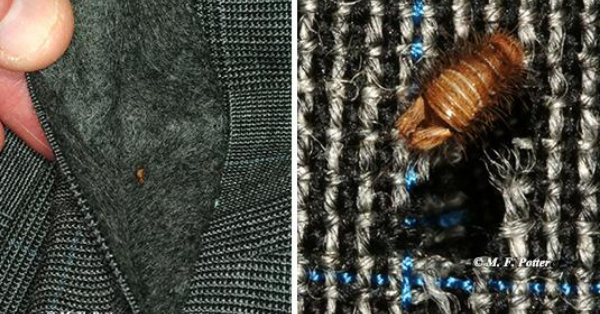
You’ll also have to pay special attention to clothing, bedding, towels, etc. Larvae are usually found in folds and collars, but they can be anywhere!
Although carpet beetles might not eat all of your clothes, that doesn’t mean that there can’t be beatles exploring around. So, check all your clothes for beetles and larvae! Remember, they can be quite small!
Once you’ve identified all the items that are or may have been infested, it’s time to wash all of the fabrics on high heat. We’re talking over 120º Farenheit. We do this to ensure that we’re killing beetles, larvae, and eggs!
If you’re unable to wash some items (like those made of silk), you’ll have to take them to the dry cleaner. It’s the only way!
– Steam Clean Carpets and Furniture
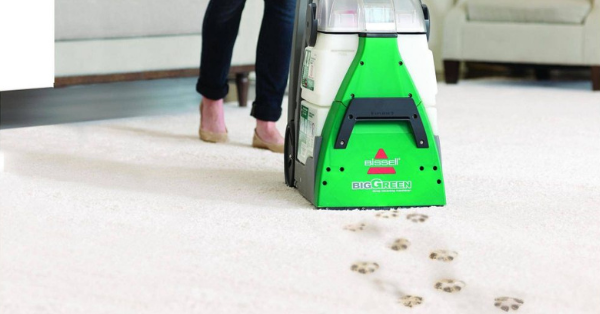
Do you have a carpet steam cleaner? If you don’t, please get one! Is by far the wisest investment any carpet owner can make. They’re super simple to use, they will save you a lot of money (because you wont have to call a professional to clean your carpet), and they work like a charm!
And in case you have carpet beetles, it’s the only machine that will help you remove the little beetles and eggs that you might not see.
We have a post on the best carpet steam cleaners of 2022. I’m sure you’ll find what you need there! This is a carpet steam cleaner machine, for those of you who’ve never checked one out:
[amazon link=”B00450U6CS” title=”Bissell Big Green Professional Carpet Cleaner Machine:”/]
[amazon box=”B00450U6CS”]
And don’t forget about steam cleaning your furniture! Carpet beetles could be hiding in your furniture just as much as on the carpet. Don’t let the name deceit you!

– Taxidermy animals
Finally, we have to take care of any taxidermy animals you might have home. These are a carpet beetle magnet, so you’ll have to be extra careful.
This procedure called “Thermal Deinfestation” is described with detail in this page: Thermal Deinfestation of Hosehold Items. You’ll basically learn how to freeze the items using plastic and polyethylene sheeting. In 72 hours (+24 defreezing hours), the animals should be pest free!

Step 2: Treat with Insecticide
Once your house is ready for treatment, we’re going to apply an insecticide to our carpets and rugs, under furniture, around doors and window frames, in shelving, corners, cracks and crevices, closets… Basically everywhere where carpet beetles or larvae could live.
Make sure that you’re using an insecticide that will kill carpet beetles. Not all will! This is the one we recommend:
[amazon link=”B003AYWEL6″ title=”Tempo Ultra SC Contact Insecticide 8 oz.”/]
[amazon box=”B003AYWEL6″]
PRO TIP
MAKE SURE YOU USE AN INSECTICIDE WITH IGR
Using an Insecticide might not be enough because they don’t always kill the eggs. That’s why you need to add an IGR. IGR stands for Insect Growth Regulator. It’s a chemical product that will make sure that any treated eggs don’t hatch. Without it, there’s no guarantee that those eggs won’t cause another infestation in the future.
This is the one I recommend: [amazon link=”B00860X7R4″ title=”Gentrol Insect Growth Regulator (IGR) “/]
[amazon box=”B00860X7R4″]
I found that this, together with the [amazon link=”B003AYWEL6″ title=”Tempo Ultra SC Contact Insecticide 8 oz.”/] is the best solution against carpet beetles!
[amazon box=”B000E28UQU”]
Read the manufacturers instructions to see whether or not the insecticide can be applied to the whole carpet or just to certain spots or the edges. You want to apply it to every corner where a carpet beetle might have put eggs. That includes:

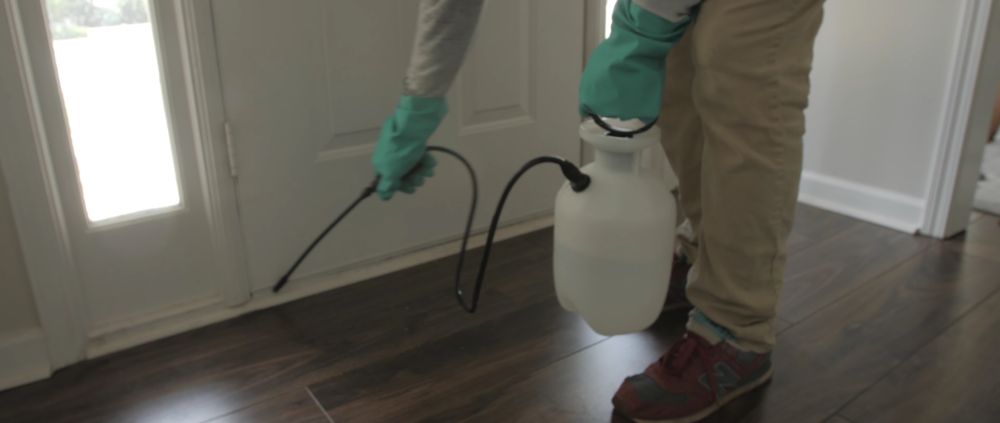
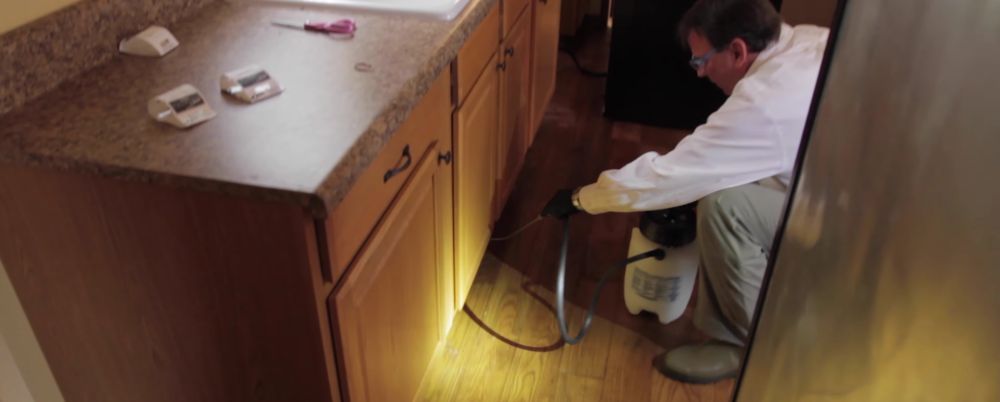
CAUTION!
Try the insecticide in an inconspicuous are before applying it to the whole carpet. We want to make sure that it doesn’t stain your carpet (for whatever reason!).
Step 3: Insecticide Dust for Hard to Reach Areas
After the insecticide spray has dried, apply insecticide dust in the places that were hard to reach with the spray. The dust should be applied every 6 months.
This is the one that I recommend using: [amazon link=”B0184HW7SI” title=”CimeXa Dust Insecticide”/]
Remember! You’ll also need a [amazon link=”B00967J4PK” title=”Powder Duster”/]:
[amazon box=”B0184HW7SI”]
[amazon box=”B00967J4PK”]
And these are just a couple of images on where to apply it:
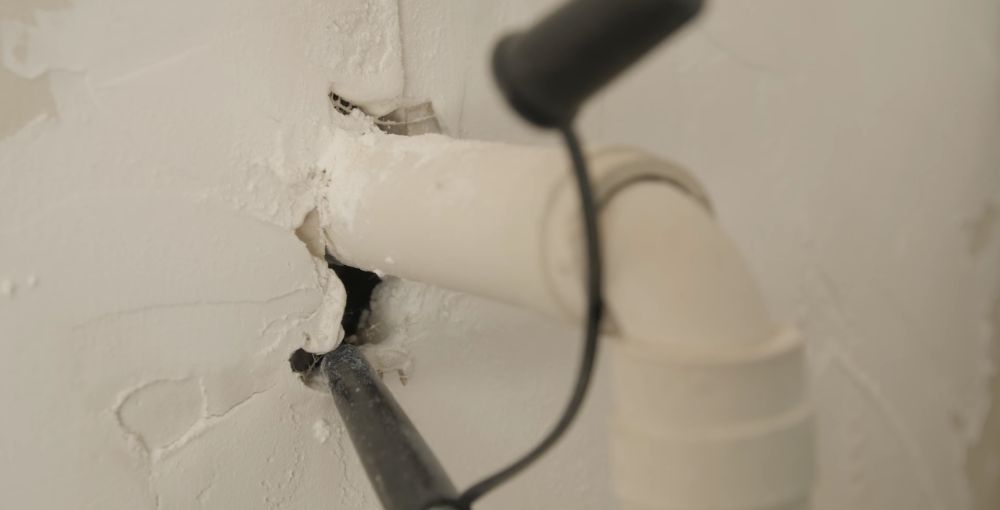

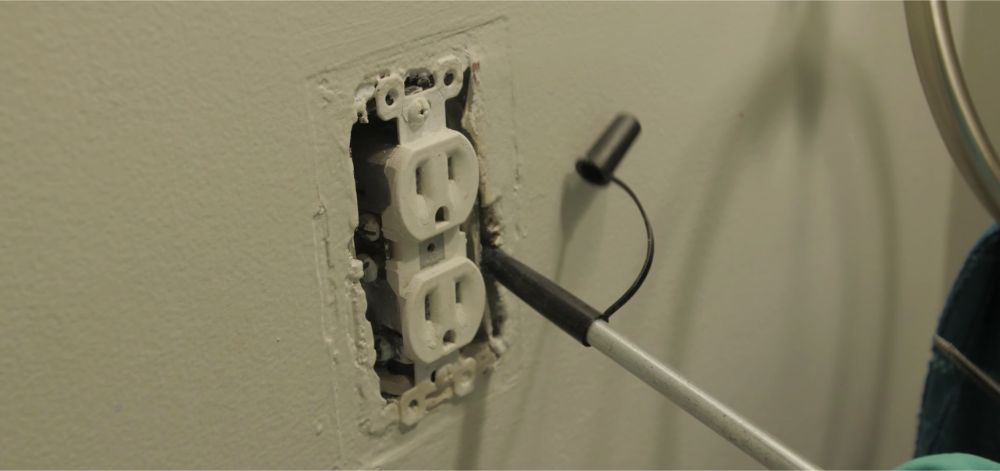
PRO TIP
USE GLUE BOARD TRAPS TO MONITOR THE INFESTATION
After you’ve applied the insecticide dust, you can place bug traps where you found carpet beetles (closets, pantries, and other dark areas etc). That way you can monitor how the infestation is doing.
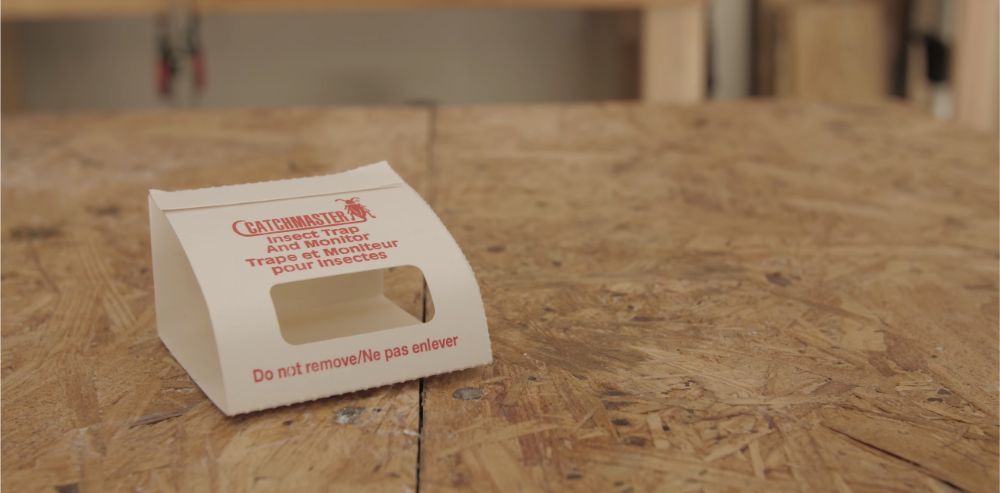
If you continue to see activity in the next 21 days, retreat the area.
When should you call a professional?
I honestly think that store insecticides are very good to keep carpet beetles in check. So much in fact that I only recommend calling a professional whenever a DIY solution has failed. If it has failed it might be because of two reasons:
1. Because you didn’t kill all the carpet beetle eggs. If the method previously described didn’t kill all the eggs it’s probably because the infestation is worse that you previously thought. Professionals have tougher chemicals that will help!
Make sure you tell them what product you used yourself. That way they’ll see that they have to use a much tougher product. Sometimes they have different products and will choose one or another depending on how badly infested a house is.
2. Your house is very prone to infestations. It is possible that you did kill all the beetles, larvae and eggs. However, you house is so prone to infestations that they keep coming back again and again.
In this case calling the professionals is the best option because their prevention treatments will last longer than commercial treatments.
How much will it cost?
Hiring a professional carpet beetle removal service is going to be a lot more expensive than taking care of it yourself. However, you can save a lot of money if you hire periodical visits.
The following table contains the range of typical costs:
| Type of Visit | Cost |
|---|---|
| One Time | $300 – $600 |
| Initial Visit | $150 – $190 |
| Monthly Visits | $40 – $50 |
| Bi-Monthly Visits | $50 – $70 |
| Quarterly Visits | $100 – $300 |
Conclusion
And that’s it! Thanks so much for reading such a long post.
You’re now an expert in carpet beetles! And I really hope you can get rid of them soon!
